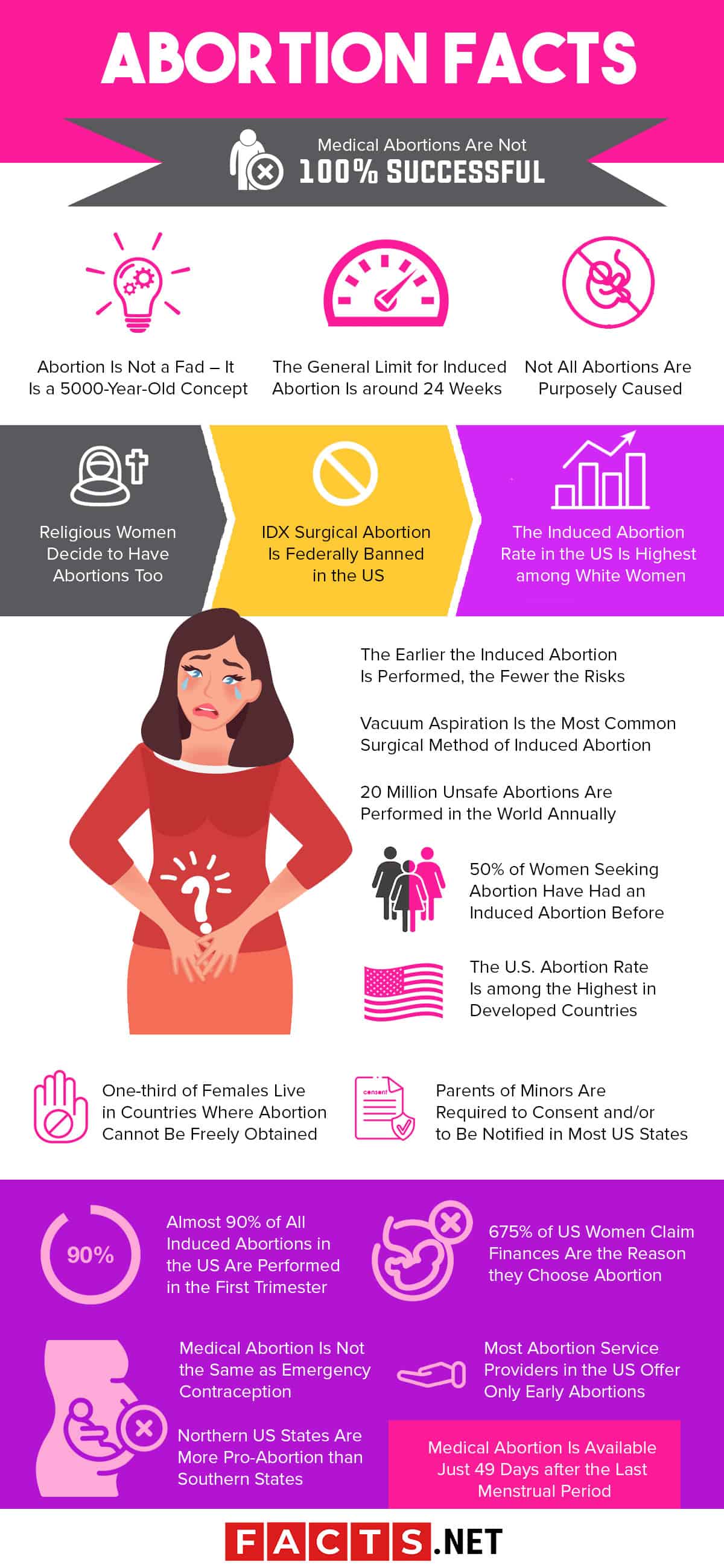
- Definition: Termination of pregnancy
- Types: Miscarriage, induced abortion
- Methods: Medical, surgical
- History: Ancient Chinese, Egyptians, Romans
- Statistics: More than 40 million per year (21% of known pregnancies)
- Legal Abortion: Laws vary throughout the world
- Cost: $400-$500 on average in the US
- Debate: Political, moral, religious
- Time: First, second trimester
- Side Effects: Physical, emotional
- History: Abortion Is Not a Fad – It Is a 5000-Year-Old Concept
- Definition: Not All Abortions Are Purposely Caused
- Limits: The General Limit for Induced Abortion Is around 24 Weeks
- Risks: The Earlier the Induced Abortion Is Performed, the Fewer the Risks
- Types: Vacuum Aspiration Is the Most Common Surgical Method of Induced Abortion
- Types: Medical Abortions Are Not 100% Successful
- Statistics: 20 Million Unsafe Abortions Are Performed in the World Annually
- Statistics: Almost 90% of All Induced Abortions in the US Are Performed in the First Trimester
- Laws: One-third of Females Live in Countries Where Abortion Cannot Be Freely Obtained
- Laws: Parents of Minors Are Required to Consent and/or to Be Notified in Most US States
- IDX Surgical Abortion Is Federally Banned in the US
- 50% of Women Seeking Abortion Have Had an Induced Abortion Before
- The U.S. Abortion Rate Is among the Highest in Developed Countries
- The Induced Abortion Rate in the US Is Highest among White Women
- Religious Women Decide to Have Abortions Too
- 75% of US Women Claim Finances Are the Reason they Choose Abortion
- Most Abortion Service Providers in the US Offer Only Early Abortions
- Medical Abortion Is Available Just 49 Days after the Last Menstrual Period
- Medical Abortion Is Not the Same as Emergency Contraception
- Northern US States Are More Pro-Abortion than Southern States
Abortion Facts Infographics

Abortion Is Not a Fad – It Is a 5000-Year-Old Concept
A lot of people think that abortion is a fad of recent decades, since there was not much talk about it prior to that. Abortion facts reveal, however, that abortion is much older than the 20th century human rights movements which most people directly connect to women’s modern freedom to choose. The first induced abortions can be traced back to ancient China in 2700 BC, which means that performing abortions has been a part of human life for almost 5,000 years.
Not All Abortions Are Purposely Caused
Nowadays, most people connect the term abortion with a conscious decision to terminate a pregnancy, but abortion facts show that the proper scientific use of the term is much broader. Abortion is any termination of a pregnancy, whether being a conscious decision (known as induced abortion) or a spontaneous occurrence. In fact, around 15-30% of all known pregnancies end in spontaneous abortion, more commonly known as miscarriage.
The General Limit for Induced Abortion Is around 24 Weeks

Normal human pregnancy lasts about 40 weeks and is typically divided into three trimesters – first 12 weeks, 13th to 28th week and 29th week to childbirth. In most of the world, abortion is generally allowed until the 24th week of pregnancy, and induced abortion after that period is extremely rare and only carried out in extreme cases where there are severe foetal abnormalities or life-threatening risks for pregnant women. Most induced abortions are carried out before week 20 – fewer than 2% are nowadays performed in week 21 or later.
The Earlier the Induced Abortion Is Performed, the Fewer the Risks
Health risks are present in every medicinal procedure, and abortion is no different. Potential health risks for the woman include bleeding, infections, anaesthesia risks, damage to the cervix, damage to internal organs, inability to conceive, psychological problems and, in extreme cases, also death.
But modern induced abortions are fairly safe – the risk of dying during an abortion is 13 times smaller than the risk of dying during childbirth; the risk is also generally lower if the abortion is carried out earlier in the pregnancy. For example, only 1 in 500,000 women die during an abortion procedure if 8 weeks or fewer pregnant, and death occurs in only 1 in 6,000 abortions performed at 21 weeks or later. All statistics above apply to safe abortions, performed by medical experts with proper equipment – if the abortion is done unprofessionally (so called “unsafe abortion”), the risks are of course much greater.
Vacuum Aspiration Is the Most Common Surgical Method of Induced Abortion
At least, it is in the early stages of pregnancy, which is when most women decide to have an abortion. With vacuum aspiration, the foetus is removed from the uterus by suction. The second most common surgical method of induced abortion is dilation and curettage (also known as D & C), also used only in early abortions. Other techniques are used later in the pregnancy – medical induction, intact dilation and extraction (IDX) or hysterectomy.
Medical Abortions Are Not 100% Successful
Medicinal methods are generally more commonly taken up among pregnant women, since they are less invasive than surgical methods (although approximately equally safe), and include the use of pharmaceuticals such as prostaglandin analogs and antiprogestogens. Medical abortions are usually between 75 and 98% successful (depending on the method used and other factors) and those that fail for various reasons have to be completed surgically.
20 Million Unsafe Abortions Are Performed in the World Annually
Abortion facts reveal that the vast majority of these procedures – 97% – are performed in developing countries, and that they cause millions of injuries and thousands of deaths each year. It is estimated that 8-13% of all pregnancy and post-pregnancy deaths worldwide are related to unsafe induced abortions. The rate of unsafe abortions is still estimated at almost 50% of all abortions performed each year.
Almost 90% of All Induced Abortions in the US Are Performed in the First Trimester
This coincides with the statistics which reveal that abortions are less likely to cause complications if they are carried out earlier in the pregnancy. Around 1 in 4 of all abortions are obtained in the first 6 weeks of pregnancy, 3 in 5 between weeks 6 and 12, 1 in 10 between weeks 13 and 20, and only 1 in 70 in week 21 or later.
One-third of Females Live in Countries Where Abortion Cannot Be Freely Obtained

Induced abortion can be legally obtained upon request in North America, and throughout much of Europe and Asia. The laws on abortion in some other parts of the world are much stricter.
Most of the countries in South America, Africa and South Asia have laws that restrict abortion only to cases of endangered maternal life, mental disability, health reasons, or a pregnancy resulting from rape. There are a few countries where abortion is not allowed under any circumstances: Vatican City, Malta, Dominican Republic, El Salvador, Nicaragua and Chile. Australia is the most divided country regarding availability of abortion – each territory has its own legislation and although abortion is not completely forbidden anywhere, the laws are very different across the country.
Parents of Minors Are Required to Consent and/or to Be Notified in Most US States
The exceptions to this rule are the states of Washington, Oregon, New York, Vermont, Connecticut and Hawaii, where no parental notification or parental consent laws exist. The strictest laws on minors and abortion are found in North Dakota and Mississippi. In these states, both parents must give their consent prior to the induced abortion of a pregnancy in a minor.
IDX Surgical Abortion Is Federally Banned in the US
The Partial-Birth Abortion Ban Act from 2003 made the surgical method of abortion, known as intact dilation and extraction (IDX), illegal across the country. Although no pregnancy time limit is specified in the law, it is aimed at preventing late second trimester abortions, since the IDX method is typically used between weeks 15 and 26 of the pregnancy.
50% of Women Seeking Abortion Have Had an Induced Abortion Before
Abortion facts reveal that these statistics are frequently used by those who oppose the freedom of induced abortion on request, since it hints that abortion is often used like an alternative form of contraception. Those who oppose abortion on moral, religious or other grounds, often argue that abortion is too easy to come by and that making it readily available encourages what they perceive as immoral and reckless behaviour.
The U.S. Abortion Rate Is among the Highest in Developed Countries

Approximately one-third of all American women have had at least one abortion by the time they are 45 years old. This statistic places the USA among the countries in the developed world with the highest rates of abortion. Most abortions are performed on young women under 25 years of age, with around 51% of induced abortions carried out among this age group.
The Induced Abortion Rate in the US Is Highest among White Women
Around 36% of all induced abortions carried out in the United States are performed on white women, 30% on African-American women, 25% among Hispanic women and 9% on women of other races. These statistics help break one of the biggest myths of abortion facts, namely that women from racial minorities in the US are more inclined toward having an induced abortion.
Religious Women Decide to Have Abortions Too
Abortion facts reveal that 37% of US women who have had an induced abortion identify as Protestant, and another 28% as Catholic. Almost two-thirds of the women in this group have already had one or more children. This demonstrates that although some groups of people oppose induced abortion on religious grounds, many women who affiliate themselves with a particular religion do choose to terminate their pregnancies.
75% of US Women Claim Finances Are the Reason they Choose Abortion
Some 3 out of every 4 women in the US who have had an abortion say that they could not afford to have a child. But abortion facts reveal some interesting statistics – only 42% of all women who have had an abortion have a yearly income below the federal poverty level limit. Around 27% have an income of between 100% and 199% of the federal poverty level, and the remaining 31% of women who have had an abortion have a yearly income of 200% or more of the federal poverty limit.
Most Abortion Service Providers in the US Offer Only Early Abortions
Although the general acceptable medical limit for induced abortion is around 24 weeks of pregnancy, most abortion providers offer their services only in the earlier stages of pregnancy. Abortion facts statistics reveal that some 61% of providers offer abortion in the second trimester, but only 34% offer it at week 20 or later, and only 16% carry out terminations at week 24.
Medical Abortion Is Available Just 49 Days after the Last Menstrual Period

Women in the early stages of pregnancy can choose between medical and surgical abortion, but as the pregnancy progresses, surgical abortion becomes the only option. Women who decide to opt for an abortion early enough usually take a combination of two medications: mifepristone, which blocks the hormone progesterone, and Misoprostol, which causes the uterus to contract and push the embryo out.
Medical Abortion Is Not the Same as Emergency Contraception
Both involve the use of medications, but medical abortion is a termination of the pregnancy, while emergency contraception (also commonly known as the morning-after pill) prevents the pregnancy before it even starts. The so-called morning-after-pill can be taken up to five days after unprotected intercourse took place. It can cause side-effects such as nausea and vomiting in some women but is largely effective at preventing pregnancy.
Northern US States Are More Pro-Abortion than Southern States
Although induced abortion is not illegal in any of the US states, many states have severe limitations regarding when a women is allowed to have an abortion. Research shows that northern states are typically more accepting of the idea of freedom of choice – 70% of the New England population supports abortion being legal in all or most cases and so does 65% of the Mid-Atlantic States population, but the share is only 40% in the South Central States and 50% in the South Atlantic States.
Abortion Facts— Facts about Abortion Summary
 Abortion is defined as the early termination of pregnancy and can be either induced or spontaneous – in that case it is known as a miscarriage. Induced abortion can be performed by medications or surgical procedure, depending on how advanced the pregnancy is. The general acceptable limit for an induced abortion is set at 24 weeks of pregnancy, although most women decide to have it performed in the first trimester or early second trimester. There has been a heated debate on abortion in public and political circles for decades – those who oppose it claim it to be murder and just a means of contraception for irresponsible women, and those who support it claim that women have the right to choose freely within acceptable medical boundaries.
Abortion is defined as the early termination of pregnancy and can be either induced or spontaneous – in that case it is known as a miscarriage. Induced abortion can be performed by medications or surgical procedure, depending on how advanced the pregnancy is. The general acceptable limit for an induced abortion is set at 24 weeks of pregnancy, although most women decide to have it performed in the first trimester or early second trimester. There has been a heated debate on abortion in public and political circles for decades – those who oppose it claim it to be murder and just a means of contraception for irresponsible women, and those who support it claim that women have the right to choose freely within acceptable medical boundaries.
Was this page helpful?
Our commitment to delivering trustworthy and engaging content is at the heart of what we do. Each fact on our site is contributed by real users like you, bringing a wealth of diverse insights and information. To ensure the highest standards of accuracy and reliability, our dedicated editors meticulously review each submission. This process guarantees that the facts we share are not only fascinating but also credible. Trust in our commitment to quality and authenticity as you explore and learn with us.


